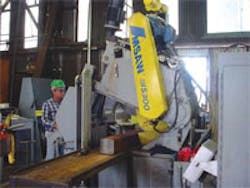Clifford- Jacobs Sees Saw Advantages
Clifford-Jacobs, a Champagne, IL, forging company, has become a major supplier to the aerospace, off-road construction, mining, forestry, truck, military, rail transit, and the oil/gas equipment markets worldwide since its founding in 1919 by Cass Clifford and David Jacobs.
The early history of the company includes a great story of tenacity and determination to succeed. Following a fire that nearly destroyed the business and the onset of the Great Depression, Jacobs and the company’s one employee cut, forged, and trimmed an order of 300 service hubs for Chevrolet — at fifty cents apiece. To save additional shipping cost, the men loaded the product into wheelbarrows and hauled them to the local rail station in Champaign.
Today, the company’s Total Quality program mandates continuous improvement in management tasking, production reporting, and especially equipment upgrades, to maintain the highest level of quality and consistency possible.
While the company centers on the forging process with several steam hammers rated between 1,500 and 25,000 lb., the billet- blanking saw department is where the process begins. Here, one of the original Metalcut billet-cutting saws, the sixth one ever built by a man named Willy Goellner in 1971, and still functioning today, cuts billets up to 12 in. in diameter, to prepare the blanks for the forging process. Goellner designed and built those saws for Metalcut at his own company, Advanced Machine & Engineering Co. (www.ame.com).
Willy Goellner continues as chairman at AME, running the business along with his sons. Recently, he designed a new generation of saw, tradenamed Amsaw, for today’s cutting needs, based on state-of-the-art machine technology.
AME recently installed one of these units, the Amsaw S300, for use on 3- to 12- in. billets at Clifford-Jacobs. According to Mike Snell, C-J’s v.p.-manufacturing, the heaviest use is for stock 6 to 9 in. in diameter.
“We process a very wide variety of materials here at Clifford-Jacobs, and we use the Amsaw for all but some aerospace and stainless grades,” Snell reports. “That covers carbon, alloy and bearing steels, calcium- treated, VIM-VAR, and customersupplied proprietary grades from such leading companies as Caterpillar, Westinghouse, GE, and Boeing Aerospace.”
In the sawing department, Snell explains, long bar stock is off-loaded by overhead crane and fed directly onto the saw tables. On the new Amsaw S300, a PLC maintains the precise feed settings and monitors the loading system.
According to AME, this particular style of carbide billet-cutting saw outperforms a band saw by a factor of eight, at a lower cost per square inch of material cut.
Snell says that, while Clifford- Jacobs has not studied that particular comparative aspect of the saw’s performance, he is certain the Amsaw makes a discernible difference in the overall output of the sawing department at his company.
The same grind is provided Clifford- Jacobs on all saw blades by a local source, which supplies new blades and sharpening services.
Clifford-Jacobs turns to AME for all machine service and rebuild/ upgrading work as part of a scheduled predictive maintenance procedure. Snell, a 21-year employee of Clifford-Jacobs, explains, “Our contact at AME, Steve Swanson, has been with Willy (Goellner) at the company, almost since the beginning. We can call on him and know our work is being handled by someone who is familiar with us, our needs, and the particulars of our process.”
Beyond this working relationship, the performance of the Amsaw is what most appeals to Snell, who says they can hold +/- 0.010 in. or better tolerances routinely on the material blanks, including the hardest materials that Clifford-Jacobs processes. He credits the design of the Amsaw machine, which uses a pivot point rather than older technologies to maintain this consistent cutting action.
The Amsaw S300 at Clifford- Jacobs was one of the first such machines installed and Snell admits there were some difficulties at the outset. “The initial problems took a while to solve, but AME and C-J stuck with it and, in the end, we got exactly what we wanted from the machine. That’s a credit to both AME and us, but when you’ve relied on a supplier for so long, it’s worth having them as a cooperative partner. We’d like to think our customers have the same attitude towards us.”
The smaller saws in the department have been rebuilt approximately every eight years, according to Snell, who predicts the Amsaw S300 might go 20 years before requiring a rebuild. “We use the machines constantly about 50 hours each week, with only a routine maintenance shutdown, every July.”
Snell also comments that the training provided by AME for his three operators in the Clifford-Jacobs sawing department was thorough and allowed each operator to become productive very quickly.
